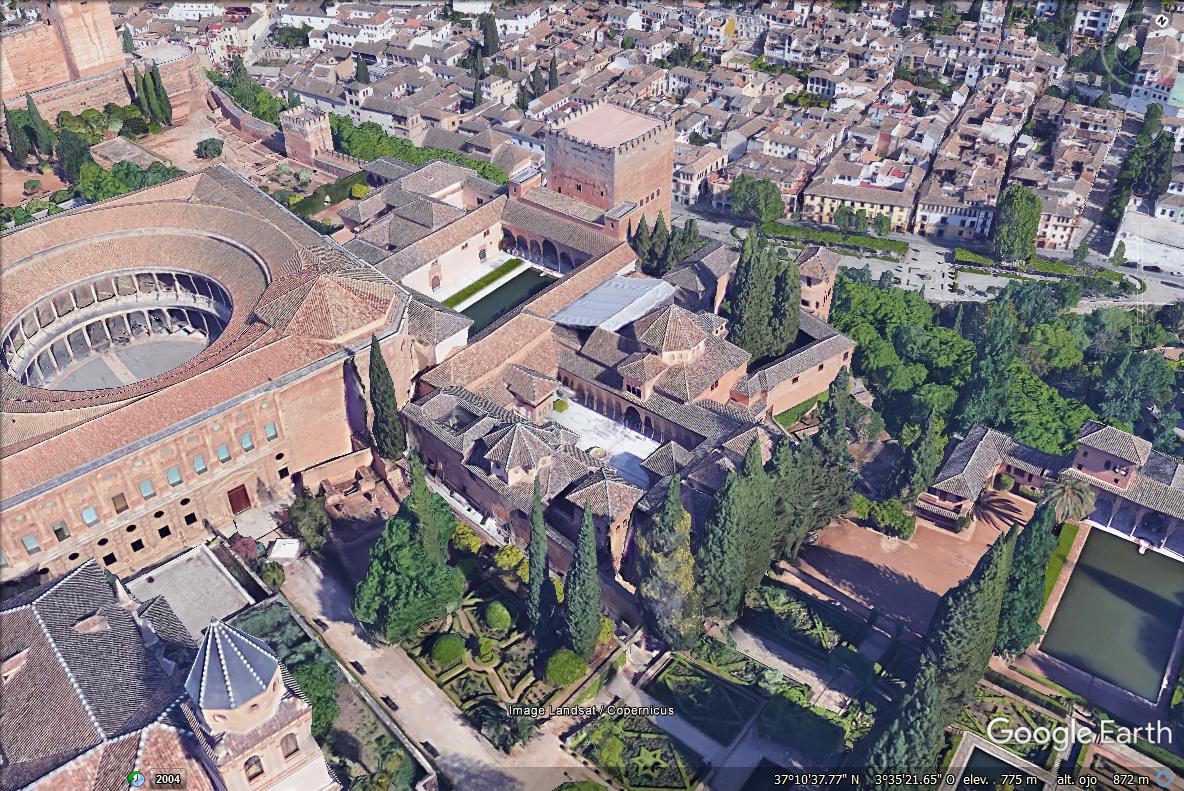Nasrid Palaces
An unique palatial complex that represents the top of islamic art and culture in Spain.

The complex of the palaces of the Alhambra which was the residence of kings and sultans in Granada for centuries.
An unique palatial complex that represents the top of islamic art and culture in Spain.

You cannot realize the palaces that are inside the Alhambra unless you are inside or from the air. Those are the bes preserved Palaces from the culture and islamic art from Andalusia.
Se tratan del conjunto de edificios que hizo erigir Muhammad V como residencia personal y para los servicios de la corte. Los palacios no se concibieron como un plan de construcción único, si no que se fué aprovechando lo construido para ir ampliándolo. Las tres partes principales son el Mexuar, el Palacio de Comares y el Palacio de los Leones.
Son también denominados Casa Real Vieja para distinguirla de la Casa Real Nueva, palacio renacentista que hizo construir Carlos V.
The Nasrid Palaces were built at the request of Muhammad V in the second half of the XIV century, taking advantage of what was already built by his father Yusuf I since 1335.
Cada una de las zonas del conjunto no se distinguen solamente por el uso que tenía sino también por su estructura artística debido a sus diferentes momentos de construcción. El Palacio de Comares es de construcción musulmana, mientras que el Patio de los Leones tiene notas de influencia cristiana.
Tras la reconquista los Palacios Nazaríes han sufrido constantes modificaciones y restauraciones, siendo las de Carlos V las de mayor envergadura ya que añadió numerosas habitaciones y creando la Casa Real Nueva.
This is the itinerary you will follow during your visit, with some photos and brief descriptions.
After the small entrance square you will find the first court and go to the Court of Machuca (named after the surname of Charles V's architect).
This court has a big central cistern which is called in Arabic "zafariche de peregrina forma" and which was modified in the Christian epoch.
In the northern area of the court, the arcs that build an arcade stand out. In the southern area, where the arcs built by the cypresses can be found, must have existed another arcade, similar to the same structure of the arcs.
If we cross the court and continue to the east, we will enter the Great Hearing Room or Mexuar.
This room served for important hearings and reunions. The sultan used to sit on an elevated stand and gave justice. At the end of the room there is a small room which served as a chapel and that is why it is oriented differently to meet the religious norm.
The decoration which we can observe is different from what could have been in ancient times. Originally, it had a central lantern space from which only the 4 columns are preserved.
In the XVI century the room was adapted again, adding an upper floor to transform it into a chapel.
Crossing the room we will arrive at the Golden Court and Room.
Here was where the sultans of the XIV century welcomed their citizens.
The access to this court and room has its explanation. This narrow door, which is shaped like a horseshoe arch, allows only one person at a time access so that the guardsmen could easily control its access.
Once having passed this control, one gained access to the Golden Room, which served as a waiting room.
This area was namend after the painted wooden ceiling that covers the homonymous room. This ceiling was installed after the reconquest during the reign of the Catholic Kings, as deduced by its heraldic and decorative motives of the new residents.
In the centre of the court also stands out the replica of the Lindaraja fountain, currently preserved in the Museum of the Alhambra.
After going through this court and room, we arrive at the Court of the Myrtles.
This court started with the Comares Palace. It was built by Yusuf I and his son Muhammad V finished its construction and decoration. It is accessed through the court of the Golden Room.
This was the residence of the sultan and his family and inside the Comares Tower was the Hall of the Throne. The centre of the palace is occupied by this court of the rectangular elongated plant that has a central flanked cistern by flowerbeds of the myrtles and porticos on its shorter sides.
The court was the axis of the residence and its surroundings distributed the rooms. It is called Court of the Myrtles due to the beds of plants and flowers that grow on the sides of the cistern.
The fountain which provides the cistern with water has a peculiar design. The water comes out forcefully from the fountain but slows down bit by bit until it disappears in the tip in order to avoid noises and the oscillation of the water.
This room does not get its name because of the shape of the boat that has the ceiling, as popularly believed. Its name is due to the Arabic word "al-Baraka" which means the blessing, since in this room one requested divine assistance in order to help the sultan take possession of the throne in the adjoining room of the Comares or hall of the throne.
On the thresholds of each access to the rooms stand out the decorative elements called "taqas".
This is the biggest room of the entire monumental enclosure, named after the stained-glass windows that were inside and which are called "qamriyya" in Arabic.
Each of the walls of the tower has three small entrances to give rise to a total of nine bedrooms, all the same except the central since it was the sultan's one.
From this balcony we can look at the court of the Wought Iron Grille and a wonderful view of Albaicín, one of the historical districts of Granada.
It is named after the area of the corridor of the terrace that is latticed to protect the rooms to which it gives way.
Years after the reconquest of the ancient Nasrid kingdom of Granada, Charles V came to the city in 1526 and decided to place his accommodation in the Alhambra. In 1528 they began to build a series of new rooms for the emperor's residence and Pedro Machuca was in charge of this task.
In one of these rooms, exactly in the Hall of the Fruits also resided Washington Irving, writer of the famous Tales of the Alhambra.
The court of the lions may probably be the most characteristic image of the Alhambra of Granada.
It is surrounded by 124 marble columns of Macael.
There are four rooms surrounded by the court from where a small canal gushes which flows to the fountain of the lions. The fountains represent the four rivers of the Paradise.
They thought about many legends and theories concerning why there are 12 lions that form the fountain. The most consistent theory is probably the Hebrew meaning of the 12 lions of the tribes of Israel.
This room was the king's bedroom and a bloody legend weighs on this room, the end of the Abencerrages.
The family of the Zegríes accused the sultan's favourite of adultery with an Abencerrages gentleman. The sultan, full of anger, called the 32 Abencerrages gentlemen one after another and had them decapitated over the fountain so that the water could wash away the blood and those who waited for the fateful destiny had nothing to fear.
The room is divided into two rooms, the bedroom and the living area.
The room is divided into three areas and in each of them we find paintings in their vaults. In the central area the room is named after the painting since it represents ten kings of the Alhambra. In the lateral rooms men and Christian ladies are shown, fruit of the relationships of the kingdom with neighboring kingdoms.
In this room the first mass in the Alhambra took place when the Catholic Kings conquered Granada.
Its name derives from the two enormous marble tiles which are arranged on the floor of the room. This complex of the rooms served as a place of residence of the sultana.
The room has a fountain with a channel that carries the water to the court of the lions. The dome of muqarnas was elaborated taking into account the natural lighting of the room, obtaining the shape of a flower that contemplates when observing it.
If you want to know more about the Alhambra and if you wish to receive first-hand information, we invite you to get to know the monument on one of our guided tours. Travel with us through the history of all the parts of the Alhambra.